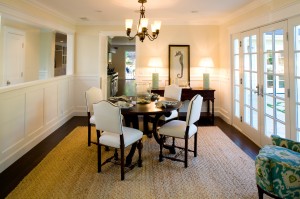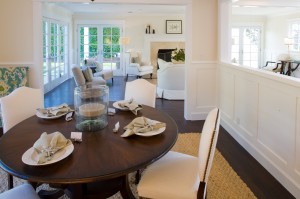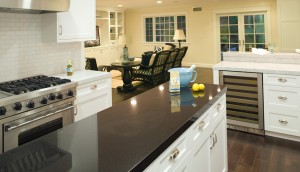Bugatti Type 41 1926–1933
 Better known as the Royale because of its intended customer base, the Bugatti Type 41 was an enormous car. It weighed 3.5 tons, stretched 21 feet, rested on 24-inch wheels, and was powered by a 12.7-liter straight-8 engine. The car, which could cost $40,000 or more when new, depending on the bodywork, arrived a few years before the world economy plummeted into the Great Depression. Consequently, Bugatti built only six, each with unique bodywork, and sold only four.
Better known as the Royale because of its intended customer base, the Bugatti Type 41 was an enormous car. It weighed 3.5 tons, stretched 21 feet, rested on 24-inch wheels, and was powered by a 12.7-liter straight-8 engine. The car, which could cost $40,000 or more when new, depending on the bodywork, arrived a few years before the world economy plummeted into the Great Depression. Consequently, Bugatti built only six, each with unique bodywork, and sold only four.
Duesenberg Model J/SJ 1928–1937
 Duesenberg Motors Corp. built 481 examples of the Model J and its variants, including the supercharged SJ (said to be capable of 140 mph), which debuted in 1932. Owned by such luminaries as the kings of Italy and Spain, the queen of Yugoslavia, the Duke of Windsor, William Randolph Hearst, Howard Hughes, Clark Gable, and Gary Cooper (the latter two drove the only two 400 hp SSJ short-wheelbase convertibles), the Model J became a symbol of wealth and glamour.
Duesenberg Motors Corp. built 481 examples of the Model J and its variants, including the supercharged SJ (said to be capable of 140 mph), which debuted in 1932. Owned by such luminaries as the kings of Italy and Spain, the queen of Yugoslavia, the Duke of Windsor, William Randolph Hearst, Howard Hughes, Clark Gable, and Gary Cooper (the latter two drove the only two 400 hp SSJ short-wheelbase convertibles), the Model J became a symbol of wealth and glamour.
Bugatti Type 57 1934–1940
 The original Bugatti Type 57 was designed by Jean Bugatti, a son of the company’s founder, Ettore Bugatti, but the marque also built a number of Type 57 variants, including the Type 57S. Set on a lower chassis, the Type 57S (the S stood for surbaissé, or “lowered”) had a V-shaped dip at the bottom of its radiator. Bugatti produced only four examples of what has become the most coveted Type 57S body style, the Atlantic. The Atlantic’s signature design element is the pronounced dorsal seam that runs the length of the car. The seam contained the rivets that held the aluminum body panels together.
The original Bugatti Type 57 was designed by Jean Bugatti, a son of the company’s founder, Ettore Bugatti, but the marque also built a number of Type 57 variants, including the Type 57S. Set on a lower chassis, the Type 57S (the S stood for surbaissé, or “lowered”) had a V-shaped dip at the bottom of its radiator. Bugatti produced only four examples of what has become the most coveted Type 57S body style, the Atlantic. The Atlantic’s signature design element is the pronounced dorsal seam that runs the length of the car. The seam contained the rivets that held the aluminum body panels together.
Alfa Romeo 8C 2900B 1937–1938
 With a top speed of 120 mph, the 180 hp Alfa Romeo 8C 2900B was touted at the time of its debut as the world’s fastest production road car. It marked the debut of the Superleggera (Italian for “superlight”) body by the Italian studio Carrozzeria Touring. In addition to reducing the weight of the car (and thus increasing its speed), the style also allowed for innovative body shapes such as the one on the 8C 2900B Mille Miglia Spider. Alfa Romeo built a total of about 30 2900B models.
With a top speed of 120 mph, the 180 hp Alfa Romeo 8C 2900B was touted at the time of its debut as the world’s fastest production road car. It marked the debut of the Superleggera (Italian for “superlight”) body by the Italian studio Carrozzeria Touring. In addition to reducing the weight of the car (and thus increasing its speed), the style also allowed for innovative body shapes such as the one on the 8C 2900B Mille Miglia Spider. Alfa Romeo built a total of about 30 2900B models.
Talbot-Lago T150C 1937–1939
 The Talbot-Lago T150C’s signature teardrop silhouette is credited to Figoni and Falaschi’s Joseph Figoni, an Italian coachbuilder who had opened a shop in Paris in the 1920s. Figoni’s design is said to have been inspired by the aerodynamic pontoons that covered the landing gear of that era’s aircraft. Many of the 14 T150Cs that Talbot-Lago built also displayed Figoni’s innovative use of metallic paints and two- and three-tone color schemes.
The Talbot-Lago T150C’s signature teardrop silhouette is credited to Figoni and Falaschi’s Joseph Figoni, an Italian coachbuilder who had opened a shop in Paris in the 1920s. Figoni’s design is said to have been inspired by the aerodynamic pontoons that covered the landing gear of that era’s aircraft. Many of the 14 T150Cs that Talbot-Lago built also displayed Figoni’s innovative use of metallic paints and two- and three-tone color schemes.
Bentley Continental R-Type 1952–1955
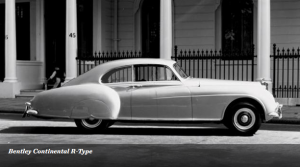 The Bentley Continental R-Type was the two-door version of the R-Type, a car that, except for a larger trunk, looked similar to its predecessor, the Mark VI. Bentley built about 2,500 R-Types during the model’s production run, and 207 of those were Continentals. H.J. Mulliner and Co., now the custom-coachwork arm of Bentley Motors, bodied most of the Continentals, fashioning them as fastback coupes. Powered by a 4.6-liter (later a 4.9-liter) straight-6 engine, the Continental achieved a top speed above 100 mph.
The Bentley Continental R-Type was the two-door version of the R-Type, a car that, except for a larger trunk, looked similar to its predecessor, the Mark VI. Bentley built about 2,500 R-Types during the model’s production run, and 207 of those were Continentals. H.J. Mulliner and Co., now the custom-coachwork arm of Bentley Motors, bodied most of the Continentals, fashioning them as fastback coupes. Powered by a 4.6-liter (later a 4.9-liter) straight-6 engine, the Continental achieved a top speed above 100 mph.
Ferrari 250 GT 1954–1964
 Ferrari produced a variety of high-performance 250 GTs, including cabriolets, berlinettas, roadsters, and coupes, though perhaps the most revered variation of the 250 GT is the 250 GTO. Ferrari produced 36 examples of what has become known as the Series I 250 GTO, and those that have survived are among the world’s most valuable collectible cars. They are coveted for their rarity, their racing heritage—Ferrari’s team of 250 GTOs won the world championship of its racing class in each of the car’s three production years—and the beauty of their slinky Scaglietti-built bodies.
Ferrari produced a variety of high-performance 250 GTs, including cabriolets, berlinettas, roadsters, and coupes, though perhaps the most revered variation of the 250 GT is the 250 GTO. Ferrari produced 36 examples of what has become known as the Series I 250 GTO, and those that have survived are among the world’s most valuable collectible cars. They are coveted for their rarity, their racing heritage—Ferrari’s team of 250 GTOs won the world championship of its racing class in each of the car’s three production years—and the beauty of their slinky Scaglietti-built bodies.
Jaguar E-Type Coupe Series 1 1961–1967
 The first of three distinct versions of the Jaguar E-Type is regarded as a work of art—not just by auto enthusiasts, but also by museum curators: The car, in convertible form, has been featured in exhibitions at London’s Design Museum and New York’s Museum of Modern Art. Its bullet-like shape is based on arcane mathematical formulas employed by the designer Malcolm Sayer, an aerodynamicist who had worked in the aircraft industry before joining Jaguar. Sayer’s design plus a 6-cylinder, 3.8-liter engine (increased to 4.2 liters in 1964) enabled the vehicle to reach a top speed of nearly 150 mph.
The first of three distinct versions of the Jaguar E-Type is regarded as a work of art—not just by auto enthusiasts, but also by museum curators: The car, in convertible form, has been featured in exhibitions at London’s Design Museum and New York’s Museum of Modern Art. Its bullet-like shape is based on arcane mathematical formulas employed by the designer Malcolm Sayer, an aerodynamicist who had worked in the aircraft industry before joining Jaguar. Sayer’s design plus a 6-cylinder, 3.8-liter engine (increased to 4.2 liters in 1964) enabled the vehicle to reach a top speed of nearly 150 mph.
Lincoln Continental (fourth generation) 1961–1969
 Originally a proposal for the Ford Thunderbird, Elwood Engel’s design for the Continental has been credited with saving the Lincoln marque from extinction. Robert McNamara, Ford’s president at the time, was prepared to terminate the Lincoln brand because of declining sales, but he saw sufficient promise in Engel’s Thunderbird design to reconsider that plan. The car was an immediate and long-term success, achieving sales of 25,160 in its first year and more than 30,000 in each of the next eight years.
Originally a proposal for the Ford Thunderbird, Elwood Engel’s design for the Continental has been credited with saving the Lincoln marque from extinction. Robert McNamara, Ford’s president at the time, was prepared to terminate the Lincoln brand because of declining sales, but he saw sufficient promise in Engel’s Thunderbird design to reconsider that plan. The car was an immediate and long-term success, achieving sales of 25,160 in its first year and more than 30,000 in each of the next eight years.
Lamborghini Miura 1966–1972
 The Miura, the first viable mid-engine sports car, might be Lamborghini’s most celebrated model, for both its mechanical and aesthetic attributes. A rolling chassis prototype of the vehicle debuted at the 1965 Turin auto show, and though the car lacked a body, showgoers still placed orders for it. The 350 hp Miura, then called the P400, received an even greater reception at the 1966 Geneva motor show, where it appeared with bodywork that was designed by Bertone’s Marcello Gandini.
The Miura, the first viable mid-engine sports car, might be Lamborghini’s most celebrated model, for both its mechanical and aesthetic attributes. A rolling chassis prototype of the vehicle debuted at the 1965 Turin auto show, and though the car lacked a body, showgoers still placed orders for it. The 350 hp Miura, then called the P400, received an even greater reception at the 1966 Geneva motor show, where it appeared with bodywork that was designed by Bertone’s Marcello Gandini.
 Writer Amy Tan, 62, photographed with her dog, Tux, in her home office. Ms. Tan spent her childhood moving from house to house. ‘Today, the house in Sausalito where I live with my husband, Lou DeMattei, reflects our desire for permanence while the interior takes into consideration a health crisis I faced 15 years ago,’ says Ms. Tan, a sufferer of Lyme disease. Ms. Tan and her husband built the house in 2006.
Writer Amy Tan, 62, photographed with her dog, Tux, in her home office. Ms. Tan spent her childhood moving from house to house. ‘Today, the house in Sausalito where I live with my husband, Lou DeMattei, reflects our desire for permanence while the interior takes into consideration a health crisis I faced 15 years ago,’ says Ms. Tan, a sufferer of Lyme disease. Ms. Tan and her husband built the house in 2006.
 Better known as the Royale because of its intended customer base, the Bugatti Type 41 was an enormous car. It weighed 3.5 tons, stretched 21 feet, rested on 24-inch wheels, and was powered by a 12.7-liter straight-8 engine. The car, which could cost $40,000 or more when new, depending on the bodywork, arrived a few years before the world economy plummeted into the Great Depression. Consequently, Bugatti built only six, each with unique bodywork, and sold only four.
Better known as the Royale because of its intended customer base, the Bugatti Type 41 was an enormous car. It weighed 3.5 tons, stretched 21 feet, rested on 24-inch wheels, and was powered by a 12.7-liter straight-8 engine. The car, which could cost $40,000 or more when new, depending on the bodywork, arrived a few years before the world economy plummeted into the Great Depression. Consequently, Bugatti built only six, each with unique bodywork, and sold only four. Duesenberg Motors Corp. built 481 examples of the Model J and its variants, including the supercharged SJ (said to be capable of 140 mph), which debuted in 1932. Owned by such luminaries as the kings of Italy and Spain, the queen of Yugoslavia, the Duke of Windsor, William Randolph Hearst, Howard Hughes, Clark Gable, and Gary Cooper (the latter two drove the only two 400 hp SSJ short-wheelbase convertibles), the Model J became a symbol of wealth and glamour.
Duesenberg Motors Corp. built 481 examples of the Model J and its variants, including the supercharged SJ (said to be capable of 140 mph), which debuted in 1932. Owned by such luminaries as the kings of Italy and Spain, the queen of Yugoslavia, the Duke of Windsor, William Randolph Hearst, Howard Hughes, Clark Gable, and Gary Cooper (the latter two drove the only two 400 hp SSJ short-wheelbase convertibles), the Model J became a symbol of wealth and glamour. The original Bugatti Type 57 was designed by Jean Bugatti, a son of the company’s founder, Ettore Bugatti, but the marque also built a number of Type 57 variants, including the Type 57S. Set on a lower chassis, the Type 57S (the S stood for surbaissé, or “lowered”) had a V-shaped dip at the bottom of its radiator. Bugatti produced only four examples of what has become the most coveted Type 57S body style, the Atlantic. The Atlantic’s signature design element is the pronounced dorsal seam that runs the length of the car. The seam contained the rivets that held the aluminum body panels together.
The original Bugatti Type 57 was designed by Jean Bugatti, a son of the company’s founder, Ettore Bugatti, but the marque also built a number of Type 57 variants, including the Type 57S. Set on a lower chassis, the Type 57S (the S stood for surbaissé, or “lowered”) had a V-shaped dip at the bottom of its radiator. Bugatti produced only four examples of what has become the most coveted Type 57S body style, the Atlantic. The Atlantic’s signature design element is the pronounced dorsal seam that runs the length of the car. The seam contained the rivets that held the aluminum body panels together. With a top speed of 120 mph, the 180 hp Alfa Romeo 8C 2900B was touted at the time of its debut as the world’s fastest production road car. It marked the debut of the Superleggera (Italian for “superlight”) body by the Italian studio Carrozzeria Touring. In addition to reducing the weight of the car (and thus increasing its speed), the style also allowed for innovative body shapes such as the one on the 8C 2900B Mille Miglia Spider. Alfa Romeo built a total of about 30 2900B models.
With a top speed of 120 mph, the 180 hp Alfa Romeo 8C 2900B was touted at the time of its debut as the world’s fastest production road car. It marked the debut of the Superleggera (Italian for “superlight”) body by the Italian studio Carrozzeria Touring. In addition to reducing the weight of the car (and thus increasing its speed), the style also allowed for innovative body shapes such as the one on the 8C 2900B Mille Miglia Spider. Alfa Romeo built a total of about 30 2900B models. The Talbot-Lago T150C’s signature teardrop silhouette is credited to Figoni and Falaschi’s Joseph Figoni, an Italian coachbuilder who had opened a shop in Paris in the 1920s. Figoni’s design is said to have been inspired by the aerodynamic pontoons that covered the landing gear of that era’s aircraft. Many of the 14 T150Cs that Talbot-Lago built also displayed Figoni’s innovative use of metallic paints and two- and three-tone color schemes.
The Talbot-Lago T150C’s signature teardrop silhouette is credited to Figoni and Falaschi’s Joseph Figoni, an Italian coachbuilder who had opened a shop in Paris in the 1920s. Figoni’s design is said to have been inspired by the aerodynamic pontoons that covered the landing gear of that era’s aircraft. Many of the 14 T150Cs that Talbot-Lago built also displayed Figoni’s innovative use of metallic paints and two- and three-tone color schemes. The Bentley Continental R-Type was the two-door version of the R-Type, a car that, except for a larger trunk, looked similar to its predecessor, the Mark VI. Bentley built about 2,500 R-Types during the model’s production run, and 207 of those were Continentals. H.J. Mulliner and Co., now the custom-coachwork arm of Bentley Motors, bodied most of the Continentals, fashioning them as fastback coupes. Powered by a 4.6-liter (later a 4.9-liter) straight-6 engine, the Continental achieved a top speed above 100 mph.
The Bentley Continental R-Type was the two-door version of the R-Type, a car that, except for a larger trunk, looked similar to its predecessor, the Mark VI. Bentley built about 2,500 R-Types during the model’s production run, and 207 of those were Continentals. H.J. Mulliner and Co., now the custom-coachwork arm of Bentley Motors, bodied most of the Continentals, fashioning them as fastback coupes. Powered by a 4.6-liter (later a 4.9-liter) straight-6 engine, the Continental achieved a top speed above 100 mph. Ferrari produced a variety of high-performance 250 GTs, including cabriolets, berlinettas, roadsters, and coupes, though perhaps the most revered variation of the 250 GT is the 250 GTO. Ferrari produced 36 examples of what has become known as the Series I 250 GTO, and those that have survived are among the world’s most valuable collectible cars. They are coveted for their rarity, their racing heritage—Ferrari’s team of 250 GTOs won the world championship of its racing class in each of the car’s three production years—and the beauty of their slinky Scaglietti-built bodies.
Ferrari produced a variety of high-performance 250 GTs, including cabriolets, berlinettas, roadsters, and coupes, though perhaps the most revered variation of the 250 GT is the 250 GTO. Ferrari produced 36 examples of what has become known as the Series I 250 GTO, and those that have survived are among the world’s most valuable collectible cars. They are coveted for their rarity, their racing heritage—Ferrari’s team of 250 GTOs won the world championship of its racing class in each of the car’s three production years—and the beauty of their slinky Scaglietti-built bodies. The first of three distinct versions of the Jaguar E-Type is regarded as a work of art—not just by auto enthusiasts, but also by museum curators: The car, in convertible form, has been featured in exhibitions at London’s Design Museum and New York’s Museum of Modern Art. Its bullet-like shape is based on arcane mathematical formulas employed by the designer Malcolm Sayer, an aerodynamicist who had worked in the aircraft industry before joining Jaguar. Sayer’s design plus a 6-cylinder, 3.8-liter engine (increased to 4.2 liters in 1964) enabled the vehicle to reach a top speed of nearly 150 mph.
The first of three distinct versions of the Jaguar E-Type is regarded as a work of art—not just by auto enthusiasts, but also by museum curators: The car, in convertible form, has been featured in exhibitions at London’s Design Museum and New York’s Museum of Modern Art. Its bullet-like shape is based on arcane mathematical formulas employed by the designer Malcolm Sayer, an aerodynamicist who had worked in the aircraft industry before joining Jaguar. Sayer’s design plus a 6-cylinder, 3.8-liter engine (increased to 4.2 liters in 1964) enabled the vehicle to reach a top speed of nearly 150 mph. Originally a proposal for the Ford Thunderbird, Elwood Engel’s design for the Continental has been credited with saving the Lincoln marque from extinction. Robert McNamara, Ford’s president at the time, was prepared to terminate the Lincoln brand because of declining sales, but he saw sufficient promise in Engel’s Thunderbird design to reconsider that plan. The car was an immediate and long-term success, achieving sales of 25,160 in its first year and more than 30,000 in each of the next eight years.
Originally a proposal for the Ford Thunderbird, Elwood Engel’s design for the Continental has been credited with saving the Lincoln marque from extinction. Robert McNamara, Ford’s president at the time, was prepared to terminate the Lincoln brand because of declining sales, but he saw sufficient promise in Engel’s Thunderbird design to reconsider that plan. The car was an immediate and long-term success, achieving sales of 25,160 in its first year and more than 30,000 in each of the next eight years. The Miura, the first viable mid-engine sports car, might be Lamborghini’s most celebrated model, for both its mechanical and aesthetic attributes. A rolling chassis prototype of the vehicle debuted at the 1965 Turin auto show, and though the car lacked a body, showgoers still placed orders for it. The 350 hp Miura, then called the P400, received an even greater reception at the 1966 Geneva motor show, where it appeared with bodywork that was designed by Bertone’s Marcello Gandini.
The Miura, the first viable mid-engine sports car, might be Lamborghini’s most celebrated model, for both its mechanical and aesthetic attributes. A rolling chassis prototype of the vehicle debuted at the 1965 Turin auto show, and though the car lacked a body, showgoers still placed orders for it. The 350 hp Miura, then called the P400, received an even greater reception at the 1966 Geneva motor show, where it appeared with bodywork that was designed by Bertone’s Marcello Gandini. Arabella is one of the leading landscape designers working in the UK today and has an unrivalled command of both landscape design and the highest quality plantsmanship. Italian by birth, she has been working in the UK for over 40 years designing over 400 gardens worldwide including 6 Chelsea Flower Show Gold medal gardens, including best of show in 1998.
Arabella is one of the leading landscape designers working in the UK today and has an unrivalled command of both landscape design and the highest quality plantsmanship. Italian by birth, she has been working in the UK for over 40 years designing over 400 gardens worldwide including 6 Chelsea Flower Show Gold medal gardens, including best of show in 1998.
 When Bette Midler moved to New York from Los Angeles in 1995, she was horrified by the litter strewn across the landscape. The singer and actress not only launched a one-woman pickup operation, but also founded the enormously successful New York Restoration Project (NYRP) to revitalize neglected green spaces. Just two decades later, NYRP has acquired 52 community gardens in underserved communities across the five boroughs and redesigned nearly half of them, enlisting residents in all phases of the work, from design to ongoing maintenance.
When Bette Midler moved to New York from Los Angeles in 1995, she was horrified by the litter strewn across the landscape. The singer and actress not only launched a one-woman pickup operation, but also founded the enormously successful New York Restoration Project (NYRP) to revitalize neglected green spaces. Just two decades later, NYRP has acquired 52 community gardens in underserved communities across the five boroughs and redesigned nearly half of them, enlisting residents in all phases of the work, from design to ongoing maintenance.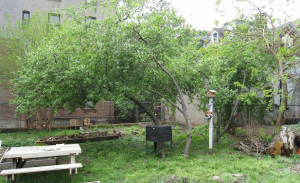 of roof-mounted photovoltaic energy collectors, provide off-the-grid community nodes where neighbors can charge phones in the wake of a blackout. And, with support from the Thompson Family Foundation and innovative porous design by architectural firm Bade Stageberg Cox, NYRP will build a boat storage facility and an outdoor classroom and science cove along the Harlem River that will host environmental-education classes. Beginning this June, it will launch a green-space takeover of an entire neighborhood, revitalizing everything from its parks and schoolyards to street trees and median strips.
of roof-mounted photovoltaic energy collectors, provide off-the-grid community nodes where neighbors can charge phones in the wake of a blackout. And, with support from the Thompson Family Foundation and innovative porous design by architectural firm Bade Stageberg Cox, NYRP will build a boat storage facility and an outdoor classroom and science cove along the Harlem River that will host environmental-education classes. Beginning this June, it will launch a green-space takeover of an entire neighborhood, revitalizing everything from its parks and schoolyards to street trees and median strips. Adriano De Souza rode his first wave at eight years old and eight years later the surf world would take notice of this young, talented surfer at the Billabong
Adriano De Souza rode his first wave at eight years old and eight years later the surf world would take notice of this young, talented surfer at the Billabong 



 Hidden rooms and passageways might seem like the stuff of a Victorian murder mystery, but these spaces are increasingly popular in homes, with owners installing them for reasons of design, security and just plain fun.
Hidden rooms and passageways might seem like the stuff of a Victorian murder mystery, but these spaces are increasingly popular in homes, with owners installing them for reasons of design, security and just plain fun. Cardok, based outside Geneva, builds garages that rise out of the ground on hydraulic lifts, allowing owners to tuck their cars neatly out of sight when they aren’t in use. “It saves space, and it’s a very discreet design,” says Izabela Waligora, a project manager at the company. “It doesn’t spoil your entrance or your garden.”
Cardok, based outside Geneva, builds garages that rise out of the ground on hydraulic lifts, allowing owners to tuck their cars neatly out of sight when they aren’t in use. “It saves space, and it’s a very discreet design,” says Izabela Waligora, a project manager at the company. “It doesn’t spoil your entrance or your garden.” 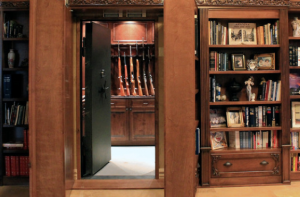 A secret door is cool, but the real fun is in how you open it, says Mr. Humble, of Creative Home Engineering. His bookshelf installation, for example, can be rigged to open via any number of mechanisms: twisting a wine bottle, pulling a candlestick, pushing on a book. “Any kind of secret switch you’ve seen in a movie, I guarantee we’ve done that for a client before,” he says.
A secret door is cool, but the real fun is in how you open it, says Mr. Humble, of Creative Home Engineering. His bookshelf installation, for example, can be rigged to open via any number of mechanisms: twisting a wine bottle, pulling a candlestick, pushing on a book. “Any kind of secret switch you’ve seen in a movie, I guarantee we’ve done that for a client before,” he says.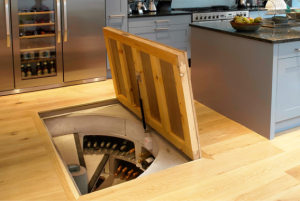 The U.K.-based Spiral Cellars company sells underground wine cellars built around a spiral-staircase design. Offering storage for a many as 1,776 bottles, the cellars are topped with trap doors that can be finished to match the surrounding flooring.
The U.K.-based Spiral Cellars company sells underground wine cellars built around a spiral-staircase design. Offering storage for a many as 1,776 bottles, the cellars are topped with trap doors that can be finished to match the surrounding flooring.
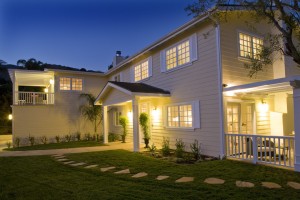 242 Surfview Dr• Offered at $3,495,000.• 4 Bed Traditional in Pacific Views Estates.• Recently redone approx. 4000 sq ft on 13,000 sq ft lot.•Room for pool and ocean views.• Just a stroll from the Getty Villa and the beach.
242 Surfview Dr• Offered at $3,495,000.• 4 Bed Traditional in Pacific Views Estates.• Recently redone approx. 4000 sq ft on 13,000 sq ft lot.•Room for pool and ocean views.• Just a stroll from the Getty Villa and the beach.
